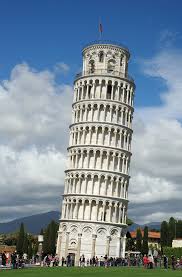This picture was found at http://en.wikipedia.org/wiki/Leaning_Tower_of_Pisa
Possible math problem: The Leaning Tower of Pisa leans at a 5.5 degree angle and has a height of 185.93 feet on its high side (left). Use what you know of the sum of interior angles of a triangle and the Law of Sines to determine the length of the horizontal displacement of the top of the tower.
This problem aligns with the following Common Core Standard:
CCSS.Math.Content.HSG.SRT.D.11
Understand and apply the Law of Sines and the Law of Cosines to find unknown measurements in right and non-right triangles (e.g., surveying problems, resultant forces).
All students will be given a copy of this picture and allowed to write on it. With the given information students should be able to use their prior knowledge to realize that creating a right triangle will aid the completion of this problem. Students should start by finding the missing angle by subtracting the angles 5.5 and 90 from 180. From their they will use the Law of Sines to find the missing lengths including the length of the displacement, the question is asking for.
This task will allow students to see how they can use their math skills outside of the classroom. Students will find finding the displacement of the Leaning Tower of Pisa interesting as it is interesting enough that a tower has tilted and is still standing and because it’s not the typical boring worksheet that students dread.

This is a great problem! Using trigonometry to find properties of a triangle that could be drawn was my first thought. I also noticed that the tower has two different cylinders that make up the tower. Another problem that could be generated from this picture is finding the volume of both cylinders. This aligns with Common Core State Standard CCSS.Math.Content.HSG.GMD.A.3. Students would have to use the volume formulas of cylinders to colve problems.